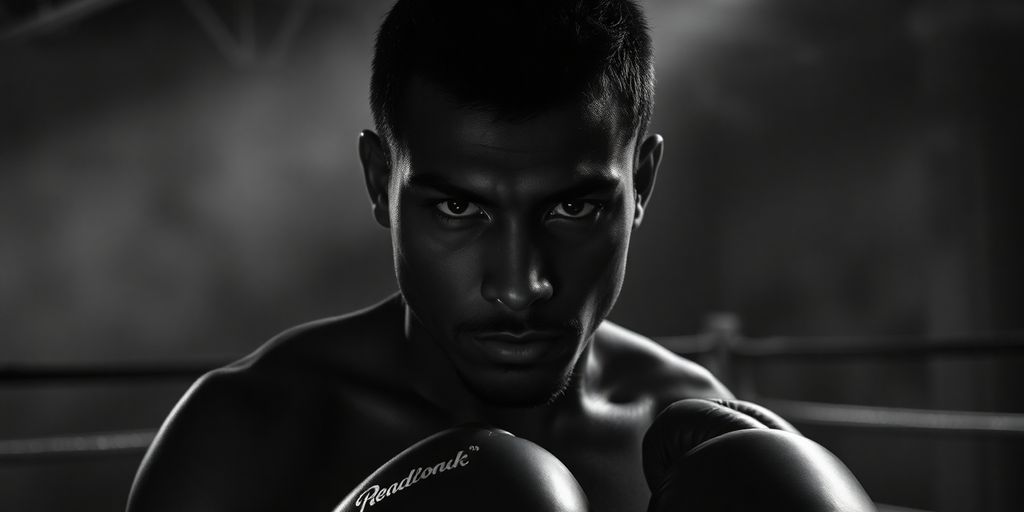Exploring Cus D’Amato on the Power of FEAR in Boxing and Life

Cus D’Amato was a legendary boxing trainer known for his unique views on fear. He believed that fear could be a powerful tool, not just in the boxing ring but in life as well. This article explores how D’Amato used fear to motivate fighters and how his ideas can help anyone facing challenges.
Key Takeaways
- Fear can push you to do your best, both in boxing and life.
- D’Amato taught that understanding fear is key to success.
- Boxers can use fear to improve their focus and performance.
- Lessons from D’Amato’s life show how to overcome fear in daily challenges.
- His teachings continue to inspire new trainers and fighters today.
The Philosophy of Fear According to Cus D’Amato
Understanding Fear as a Motivational Force
Fear is often seen as a negative feeling, but Cus D’Amato believed it could be a powerful motivator. He taught that fear can push fighters to train harder and perform better. Fear can drive you to greatness. It’s about how you use that fear to your advantage.
Fear in the Context of Boxing
In boxing, fear is everywhere. Fighters face the fear of losing, getting hurt, or disappointing their fans. D’Amato understood this and used it to help his fighters. He showed them that facing their fears could lead to success in the ring.
How Fear Shapes a Fighter’s Mindset
A fighter’s mindset is crucial. D’Amato taught that fear can either break you or make you stronger. He encouraged fighters to embrace their fears and learn from them. This approach helped many of his students become champions.
Fear is not the enemy; it’s a tool that can lead to success if you learn to control it.
Cus D’Amato’s Early Life and Introduction to Boxing
Influences That Shaped D’Amato’s Views
Cus D’Amato was born in 1908 in the Bronx, New York. Growing up in a tough neighborhood, he faced many challenges that influenced his views on fear and boxing. His experiences taught him that fear could be a powerful motivator. D’Amato was inspired by several key figures in boxing, including champions like Jack Dempsey and Joe Louis. These influences helped him develop his unique philosophy about the sport.
Early Experiences with Fear
As a young man, D’Amato encountered fear in various forms. He often felt afraid of failure and the dangers of street life. These feelings pushed him to find ways to manage fear effectively. He believed that understanding fear was essential for success, both in the ring and in life. D’Amato’s early experiences shaped his belief that fear could be transformed into a tool for growth.
The Role of Fear in D’Amato’s Training Methods
D’Amato’s training methods were revolutionary. He taught his fighters to embrace fear rather than avoid it. His approach included:
- Visualization techniques to help fighters see themselves succeeding.
- Controlled sparring sessions to expose fighters to fear in a safe environment.
- Mental exercises that focused on overcoming anxiety before fights.
Through these methods, D’Amato helped many fighters, including the legendary Mike Tyson, learn to harness their fear for peak performance.
D’Amato believed that fear, when understood and managed, could lead to greatness in the ring and beyond.
In summary, Cus D’Amato’s early life and experiences with fear laid the foundation for his innovative training methods, which continue to influence boxing today. His legacy is a testament to the power of fear as a motivational force.
Fear as a Tool for Success in the Ring
Harnessing Fear for Peak Performance
Fear can be a powerful motivator in boxing. When fighters learn to use their fear, they can push themselves to perform better. Here are some ways fear can help:
- Increased focus: Fear sharpens a fighter’s attention, helping them concentrate on their opponent.
- Adrenaline boost: The feeling of fear can release adrenaline, giving fighters extra energy during a match.
- Drive to improve: Fear of losing can motivate fighters to train harder and become better.
Training Techniques Focused on Fear Management
To succeed in the ring, fighters must learn to manage their fear. Here are some techniques:
- Visualization: Fighters imagine themselves winning, which helps reduce fear.
- Controlled exposure: Sparring with stronger opponents can help fighters face their fears.
- Breathing exercises: Deep breathing can calm nerves and help fighters stay focused.
Case Studies of Fighters Who Mastered Fear
Many successful fighters have learned to control their fear. For example:
- Artur Beterbiev: With a 20-0 record, and all 20 of those victories coming by knockout, Artur Beterbiev strikes fear into his opponents’ hearts, forcing those who share the ring with him to rethink their strategies.
- Mike Tyson: Tyson used his fear to become one of the most feared boxers in history.
- Muhammad Ali: Ali turned his fear into confidence, which helped him win many fights.
Fear can be a double-edged sword; it can either hold you back or push you to greatness. The key is to learn how to use it effectively.
The Psychological Impact of Fear Beyond Boxing
Fear in Everyday Life Situations
Fear is not just a feeling we experience in the boxing ring; it also plays a big role in our daily lives. Here are some common situations where fear can impact us:
- Public speaking: Many people feel anxious about speaking in front of others.
- Job interviews: The fear of not getting hired can be overwhelming.
- Personal relationships: Fear of rejection can hold us back from forming connections.
Lessons from the Ring Applied to Life
The lessons learned from boxing can help us deal with fear in everyday situations. Here are some key takeaways:
- Face your fears: Just like a fighter faces an opponent, we should confront our fears head-on.
- Stay focused: Keeping your mind on your goals can help reduce fear.
- Practice resilience: Learning to bounce back from setbacks is crucial in both boxing and life.
Overcoming Fear in Personal Challenges
Overcoming fear is essential for personal growth. Here are some strategies to help:
- Set small goals: Start with manageable tasks to build confidence.
- Seek support: Talk to friends or family about your fears.
- Visualize success: Imagine yourself succeeding to boost your confidence.
Fear can be a powerful teacher. By understanding and managing it, we can turn it into a tool for growth and success in all areas of life. Mental health in sports shows that engaging in activities can positively affect our well-being.
In summary, fear is a part of life that can teach us valuable lessons. By learning to manage it, we can improve our mental health and face challenges more effectively.
Cus D’Amato’s Legacy and Influence on Modern Boxing
D’Amato’s Most Famous Proteges
Cus D’Amato trained several boxers who became legends in the sport. Some of his most notable proteges include:
- Mike Tyson: Became the youngest heavyweight champion at 20.
- Floyd Patterson: The first heavyweight champion to regain his title.
- Jose Torres: A light heavyweight champion and a successful author.
The Enduring Relevance of His Teachings
D’Amato’s ideas about fear and mental strength continue to influence boxing today. His teachings emphasize:
- Understanding Fear: Recognizing fear as a natural part of boxing.
- Mental Preparation: Focusing on the mind as much as the body.
- Building Confidence: Using fear to boost self-belief in fighters.
Modern Trainers Inspired by D’Amato
Many current boxing trainers look up to D’Amato’s methods. They incorporate his principles by:
- Teaching fighters to embrace fear.
- Focusing on mental toughness in training.
- Using D’Amato’s strategies to develop champions.
D’Amato believed that fear could be a powerful tool, not just in boxing but in life. His legacy lives on through the fighters he trained and the trainers he inspired. His impact on the sport is undeniable.
Critiques and Misinterpretations of D’Amato’s Fear Philosophy

Common Misunderstandings
Many people misinterpret Cus D’Amato’s views on fear. They often think he promoted fear as a negative force. In reality, he saw it as a powerful motivator. Here are some common misunderstandings:
- Fear is only harmful.
- D’Amato encouraged fighters to avoid fear.
- Fear should not be part of training.
Criticisms from Boxing Experts
Some boxing experts have criticized D’Amato’s approach. They argue that focusing too much on fear can lead to anxiety. Here are a few points they raise:
- It may create a mindset of defeat.
- Fighters might become overly cautious.
- Not all fighters respond well to fear-based training.
Balancing Fear with Other Motivational Factors
While D’Amato emphasized fear, it’s important to balance it with other motivators. Here are some factors to consider:
- Confidence: Building self-belief is crucial.
- Discipline: Consistent training helps manage fear.
- Support: Having a strong team can ease anxiety.
Understanding fear is essential, but it should not be the only focus in a fighter’s journey. A balanced approach can lead to greater success in and out of the ring.
Personal Anecdotes and Stories from D’Amato’s Life

Memorable Quotes on Fear
Cus D’Amato often shared his thoughts on fear, emphasizing its importance in both boxing and life. Some of his most memorable quotes include:
- "Fear is like fire; it can either warm you or burn you."
- "The only thing we have to fear is fear itself."
- "A fighter who is not afraid is a fighter who is not thinking."
Stories from Fighters Trained by D’Amato
Many fighters who trained under D’Amato have shared their experiences, highlighting how he used fear to motivate them. Here are a few notable stories:
- Mike Tyson: Tyson recalls how D’Amato taught him to embrace fear, turning it into a source of strength.
- Jose Torres: Torres spoke about how D’Amato’s methods helped him face his fears in the ring, leading to his championship success.
- Floyd Patterson: Patterson often mentioned how D’Amato’s guidance helped him overcome his anxieties before fights.
D’Amato’s Personal Battles with Fear
Despite being a great coach, D’Amato faced his own fears. He believed that acknowledging fear was the first step to overcoming it.
"Fear is a part of life; it’s how we deal with it that defines us."
D’Amato’s struggles with fear made him a more relatable figure to his fighters, showing them that everyone has fears, but it’s how you handle them that matters.
Cus D’Amato was a revolutionist in the world of boxing, changing the lives of many through his unique approach to fear. His teachings continue to inspire fighters today, proving that fear can be a powerful tool for success.
Conclusion
In conclusion, Cus D’Amato’s views on fear show us that it can be both a friend and an enemy. He taught us that fear is a natural part of life, especially in boxing. Instead of letting fear control us, we can learn to use it to our advantage. D’Amato believed that facing our fears can make us stronger and help us succeed. His lessons remind us that everyone feels scared sometimes, but it’s how we deal with that fear that truly matters. By understanding and embracing our fears, we can find the courage to overcome challenges in boxing and in life.
Frequently Asked Questions
What did Cus D’Amato believe about fear?
Cus D’Amato thought that fear could be a strong force that helps people do better. He believed that fear could push fighters to train harder and perform at their best.
How did D’Amato use fear in boxing training?
D’Amato used fear as a tool in training. He taught fighters how to face their fears so they could stay calm and focused during matches.
Can fear help in life outside of boxing?
Yes, fear can help in everyday life. D’Amato believed that understanding and managing fear can help people face challenges and grow.
Who were some famous fighters trained by D’Amato?
Some well-known fighters trained by Cus D’Amato include Mike Tyson and Floyd Patterson. They learned to use fear to their advantage in the ring.
What are common misunderstandings about D’Amato’s views on fear?
Many people think D’Amato wanted fighters to be scared. In reality, he wanted them to understand and control their fear to become stronger.
How can D’Amato’s teachings be applied to personal challenges?
D’Amato’s ideas can be used to tackle personal challenges by encouraging people to face their fears and not let them hold them back.








Responses